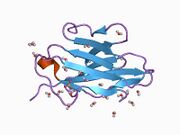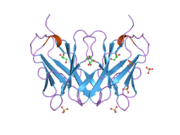Biology:CD8A
 Generic protein structure example |
CD8a (Cluster of Differentiation 8a), is a human gene.[1]
Function
The CD8 antigen is a cell surface glycoprotein found on most cytotoxic T lymphocytes that mediates efficient cell-cell interactions within the immune system. The CD8 antigen, acting as a coreceptor, and the T-cell receptor on the T lymphocyte recognize antigen displayed by an antigen-presenting cell (APC) in the context of class I MHC molecules. The functional coreceptor is either a homodimer composed of two alpha chains, or a heterodimer composed of one alpha and one beta chain. Both alpha and beta chains share significant homology to immunoglobulin variable light chains. This gene encodes the CD8 alpha chain isoforms. Two alternative transcripts encoding distinct isoforms, one membrane associated and one secreted, have been identified.[1]
Interactions
CD8A has been shown to interact with:
See also
References
- ↑ 1.0 1.1 "Entrez Gene: CD8A CD8a molecule". https://www.ncbi.nlm.nih.gov/sites/entrez?Db=gene&Cmd=ShowDetailView&TermToSearch=925.
- ↑ "CD3 delta establishes a functional link between the T cell receptor and CD8". J. Biol. Chem. 278 (5): 3257–64. January 2003. doi:10.1074/jbc.M208119200. PMID 12215456.
- ↑ 3.0 3.1 "Classical and nonclassical class I major histocompatibility complex molecules exhibit subtle conformational differences that affect binding to CD8alphaalpha". J. Biol. Chem. 275 (20): 15232–8. May 2000. doi:10.1074/jbc.275.20.15232. PMID 10809759.
- ↑ "Crystal structure of the complex between human CD8alpha(alpha) and HLA-A2". Nature 387 (6633): 630–4. June 1997. doi:10.1038/42523. PMID 9177355. Bibcode: 1997Natur.387..630G.
- ↑ "Cell-cell adhesion mediated by CD8 and human histocompatibility leukocyte antigen G, a nonclassical major histocompatibility complex class 1 molecule on cytotrophoblasts". J. Exp. Med. 174 (3): 737–40. September 1991. doi:10.1084/jem.174.3.737. PMID 1908512.
Further reading
- Molecular Biology and Function of CD4 and CD8. Advances in Immunology. 44. 1989. pp. 265–311. doi:10.1016/S0065-2776(08)60644-6. ISBN 9780120224449.
- "Roles of HIV-1 auxiliary proteins in viral pathogenesis and host-pathogen interactions.". Cell Res. 15 (11–12): 923–34. 2006. doi:10.1038/sj.cr.7290370. PMID 16354571.
- "Modelling thymic HIV-1 Nef effects". Curr. HIV Res. 4 (1): 57–64. 2006. doi:10.2174/157016206775197583. PMID 16454711.
- "Recent duplication of the two human CD8 beta-chain genes". J. Immunol. 148 (6): 1919–27. 1992. doi:10.4049/jimmunol.148.6.1919. PMID 1541829.
- "Crystal structure of a soluble form of the human T cell coreceptor CD8 at 2.6 A resolution". Cell 68 (6): 1145–62. 1992. doi:10.1016/0092-8674(92)90085-Q. PMID 1547508.
- "Regional distribution and partial molecular characterization of CD4-related mRNA in human brain and peripheral tissues". Brain Res. Mol. Brain Res. 10 (1): 23–31. 1991. doi:10.1016/0169-328X(91)90052-Y. PMID 1676132.
- "Expression of different CD8 isoforms on distinct human lymphocyte subpopulations". Eur. J. Immunol. 21 (8): 1793–800. 1991. doi:10.1002/eji.1830210803. PMID 1831127.
- "Physical associations between CD45 and CD4 or CD8 occur as late activation events in antigen receptor-stimulated human T cells". J. Immunol. 147 (10): 3434–40. 1991. doi:10.4049/jimmunol.147.10.3434. PMID 1834739.
- "Cell-cell adhesion mediated by CD8 and human histocompatibility leukocyte antigen G, a nonclassical major histocompatibility complex class 1 molecule on cytotrophoblasts". J. Exp. Med. 174 (3): 737–40. 1991. doi:10.1084/jem.174.3.737. PMID 1908512.
- "The CD4 and CD8 antigens are coupled to a protein-tyrosine kinase (p56lck) that phosphorylates the CD3 complex". Proc. Natl. Acad. Sci. U.S.A. 86 (9): 3277–81. 1989. doi:10.1073/pnas.86.9.3277. PMID 2470098. Bibcode: 1989PNAS...86.3277B.
- "Alternatively spliced mRNA encodes a secreted form of human CD8 alpha. Characterization of the human CD8 alpha gene". J. Immunol. 142 (9): 3312–9. 1989. doi:10.4049/jimmunol.142.9.3312. PMID 2496167.
- "Structure and expression of the gene encoding CD8 alpha chain (Leu-2/T8)". Immunogenetics 30 (5): 393–7. 1989. doi:10.1007/BF02425282. PMID 2509342.
- "A secreted form of the human lymphocyte cell surface molecule CD8 arises from alternative splicing". Proc. Natl. Acad. Sci. U.S.A. 86 (3): 998–1002. 1989. doi:10.1073/pnas.86.3.998. PMID 2536941. Bibcode: 1989PNAS...86..998G.
- "Expression of cDNA clones encoding the thymocyte antigens CD1a, b, c demonstrates a hierarchy of exclusion in fibroblasts". J. Immunol. 143 (5): 1723–30. 1989. doi:10.4049/jimmunol.143.5.1723. PMID 2701945.
- "An RFLP associated with pcDLeu2-14, a human T-cell differentiation antigen CD8 (Leu2) cDNA mapped to 2p12". Nucleic Acids Res. 14 (19): 7817. 1986. doi:10.1093/nar/14.19.7817. PMID 2877435.
- "A second subunit of CD8 is expressed in human T cells". EMBO J. 7 (11): 3433–9. 1989. doi:10.1002/j.1460-2075.1988.tb03217.x. PMID 3145195.
- "The isolation and sequence of the gene encoding T8: a molecule defining functional classes of T lymphocytes". Cell 40 (2): 237–46. 1985. doi:10.1016/0092-8674(85)90138-2. PMID 3871356.
- "The T cell differentiation antigen Leu-2/T8 is homologous to immunoglobulin and T cell receptor variable regions". Cell 40 (3): 591–7. 1985. doi:10.1016/0092-8674(85)90207-7. PMID 3918796.
- "Structure of Leu-2/T8 as deduced from the sequence of a cDNA clone". Behring Inst. Mitt. (77): 48–55. 1986. PMID 3936473.
External links
- CD8a+protein,+human at the US National Library of Medicine Medical Subject Headings (MeSH)
- Human CD8A genome location and CD8A gene details page in the UCSC Genome Browser.
- Human MAL genome location and MAL gene details page in the UCSC Genome Browser.
- Overview of all the structural information available in the PDB for UniProt: P01732 (Human T-cell surface glycoprotein CD8 alpha chain) at the PDBe-KB.
- Overview of all the structural information available in the PDB for UniProt: P01731 (Mouse T-cell surface glycoprotein CD8 alpha chain) at the PDBe-KB.
This article incorporates text from the United States National Library of Medicine, which is in the public domain.
 |




